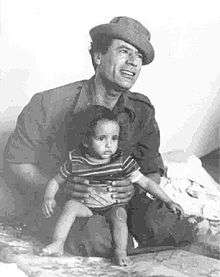Libyan Revolutionary Command Council
The Libyan Revolutionary Command Council was the twelve-person governing body that ruled the Libyan Arab Republic from 1969 to 1977. Its chairman was Muammar Gaddafi, who had the most influence.
Libyan Arab Jamahiriya
|
|---|
.svg.png) |
| This article is part of a series on the politics and government of Libya under Muammar Gaddafi |
|
Constitution |
|
Judiciary
|
|
Foreign Policy |
In 1977, the Libyan Arab Republic was abolished and Socialist People's Libyan Arab Jamahiriya was established. As a part of this, the RCC was officially abolished and replaced by the general secretariat of the General People's Congress.
Membership

The other initial members (1970) were as follows:
- Maj. Abdessalam Jallud
- Maj. Beshir al-Saghir Hawady
- Maj. Mukthar Abdullah al-Gherwy
- Capt. Abdul Moniem al-Taher el-Huny
- Capt. Mustafa al-Kharouby
- Maj. Khuwaildi al-Hamidi
- Maj. Muhammad Nejm
- Maj. Awad Ali Hamza
- Maj. Abu-Bakr Yunis Jabr
- Capt. Umar Muhayshi
- Capt. Mohammed Abu Bakr Al-Magariaf
History
Setting up a new government, the 12 member central committee of the Free Unionist Officers converted themselves into a Revolutionary Command Council (RCC), which governed the newly established Libyan Arab Republic.[1] Below them were formed a council of ministers, headed by Mahmud Sulayman al-Maghribi, to oversee the implementation of RCC policy.[2]
Captain Gaddafi was promoted to the rank of Colonel, and was recognized as both chairman of the RCC as well as the commander-in-chief of the armed forces, becoming the de facto head of state.[3] From 1970 to 1972, he also served as prime minister.
Although the RCC was theoretically a collegial body that operated through discussion and consensus building, from the start it was dominated by the opinions and decisions of Gaddafi,[4] although some of the others attempted to constrain what they saw as his excesses.[5]
Gaddafi remained the public face of the government, with the identities of the other RCC members only being publicly revealed in the Official Gazette on 10 January 1970.[6] All of them were young men, from (typically rural) working and middle-class backgrounds, and none had university degrees; in this way they were all distinct from the wealthy, highly educated conservatives who had previously governed the country.[7] The coup completed, the RCC proceeded with their intentions of consolidating the revolutionary government and modernising the country.[4]
Monarchists and members of Idris' Senussi clan were removed from Libya's political world and armed forces; Gaddafi believed that this elite were opposed to the will of the Libyan people and needed to be expunged.[8] Many figures in the old regime were imprisoned, though none were executed.[9] They maintained the previous administration's ban on political parties, and ruled by decree.[10] Further restrictions were placed on the press, and in May 1970, trade unions were banned.[11]
After Libya was converted into the "(Great) Socialist People's Libyan Arab Jamahiriya" in 1977, the remaining members of the RCC formed the apex of the "revolutionary sector" that oversaw the government. They were not subject to election, since they held office by virtue of having led the 1969 coup--officially described as "the Revolution." As a result, although Gaddafi held no formal governmental post after 1979, he continued to have the most important role in the government of the country until his overthrow and execution in the Libyan Civil War in 2011.
References
Footnotes
- Blundy & Lycett 1987, p. 63; Vandewalle 2008, p. 9; Bruce St. John 2011, p. 134.
- Blundy & Lycett 1987, p. 63.
- Blundy & Lycett 1987, p. 64; Bruce St John, p. 134.
- Bruce St John 2011, p. 134.
- Kawczynski 2011, p. 20.
- Vandewalle 2008, p. 9; Bruce St John 2011, p. 134.
- Vandewalle 2008, p. 10; Kawczynski 2011, p. 20.
- Vandewalle 2008, p. 11; Kawczynski 2011, pp. 21–23.
- Blundy & Lycett 1987, p. 62.
- Blundy & Lycett 1987, p. 63; Vandewalle 2008, p. 11; Bruce St. John 2012, p. 153.
- Blundy & Lycett 1987, p. 64.
Bibliography
- Death of a Dictator: Bloody Vengeance in Sirte. Human Rights Watch. 2012.
- Bearman, Jonathan (1986). Qadhafi's Libya. London: Zed Books. ISBN 978-0862324346.
- Blundy, David; Lycett, Andrew (1987). Qaddafi and the Libyan Revolution. Boston and Toronto: Little Brown & Co. ISBN 978-0316100427.CS1 maint: ref=harv (link)
- Bruce St. John, Ronald (2012). Libya: From Colony to Revolution (revised edition). Oxford: Oneworld. ISBN 978-1851689194.CS1 maint: ref=harv (link)
- Cooley, John K. (1983). Libyan Sandstorm. London: Sidgwick & Jackson. ISBN 978-0283989445.CS1 maint: ref=harv (link)
- Davis, Brian Lee (1990). Qaddafi, Terrorism, and the Origins of the U.S. Attack on Libya. New York: Praeger. ISBN 0275933024.CS1 maint: ref=harv (link)
- El-Khawas, Mohamad A. (1986). Qaddafi: His Ideology in Theory and Practice. Amana. ISBN 978-0915597246.CS1 maint: ref=harv (link)
- Hilsum, Lindsey (2012). Sandstorm: Libya in the Time of Revolution. London: Faber and Faber. ISBN 978-0571288038.CS1 maint: ref=harv (link)
- Metz, Helen Chapin (2004). Libya. US GPO. ISBN 1-4191-3012-9.CS1 maint: ref=harv (link)
- Monti-Belkaoui, Janice; Monti-Belkaoui, Ahmed (1996). Qaddafi: The Man and His Policies. Avebury. ISBN 978-1859723852.CS1 maint: ref=harv (link)
- Pargeter, Alice (2012). Libya: The Rise and Fall of Qaddafi. New Haven: Yale University Press. ISBN 978-0300139327.
- Simons, Geoff (2003). Libya and the West: From Independence to Lockerbie. Oxford: Centre for Libyan Studies. ISBN 1-86064-988-2.CS1 maint: ref=harv (link)
- Vandewalle, Dirk (2008), "Libya's Revolution in Perspective: 1969–2000", Libya Since 1969: Qadhafi's Revolution Revisited, Palgrave Macmillan, pp. 9–53, ISBN 0-230-33750-3
- Vandewalle, Dirk (2011), "From International Reconciliation to Civil War: 2003-2011", Libya Since 1969: Qadhafi's Revolution Revisited (revised edition), Palgrave Macmillan, pp. 215–239, ISBN 0-230-33750-3